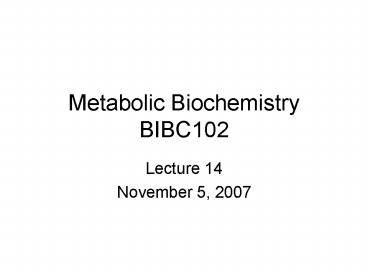Metabolic Biochemistry BIBC102 - PowerPoint PPT Presentation
1 / 46
Title:
Metabolic Biochemistry BIBC102
Description:
the order of electron flow. Red: the components are drained of electrons, i.e. oxidized ... Ce'sar Luna-Chavez,1,4 Hideto Miyoshi,5 Christophe Le'ger,6 ... – PowerPoint PPT presentation
Number of Views:98
Avg rating:3.0/5.0
Title: Metabolic Biochemistry BIBC102
1
Metabolic BiochemistryBIBC102
- Lecture 14
- November 5, 2007
2
(No Transcript)
3
LNC Fig.19.7
4
the arrangement of the complexes in the inner
membrane and the order of electron flow
5
(No Transcript)
6
Red the components are drained of electrons,
i.e. oxidized
Blue the components are filled with electrons,
i.e. reduced
7
succinate
Succinate dehydrogenase membrane bound enzyme
of Krebs cycle
Four integral membrane protein complexes Two
mobile carriers ubiquinone and cytochrome c
LNC Fig.19.15
8
oxidized Coenzyme Q or Q
reduced Coenzyme Q or QH2
LNC Fig.19.2
9
What makes proteins conductors of electrons?
They get spiked with Fe ions Fe2/Fe3
Two kinds of structures Fe-S centers and hemes
Near the end of the chain we also encounter some
Cu ions
10
Heme apoprotein cytochrome
LNC Fig.19.3
11
Structure of cytochrome c
12
LNC Fig.19.4
13
NON-HEME IRON - SULFUR CENTERS Fe2-S2 Fe4 -
S4
14
LNC Fig.19.5
15
Fe2-S2
LNC Fig.19.5
16
Fe4-S4
LNC Fig.19.5
17
LNC Fig.19.5
18
O2
NADH
19
succinate
Succinate dehydrogenase membrane bound enzyme
of Krebs cycle
Four integral membrane protein complexes Two
mobile carriers ubiquinone and cytochrome c
LNC Fig.19.15
20
7 or 8
NADH Q H ? NAD QH2
LNC Fig.19.9
21
We have the crystal structure for
this subdomainof complex I from a bacterium
7 or 8
NADH Q H ? NAD QH2
LNC Fig.19.9
22
From Sazanov and Hinchliffe (2006) Science
3111430-1436
NADH
Q
23
From Sazanov and Hinchliffe (2006) Science
3111430-1436
24
Architecture of Succinate Dehydrogenase and
Reactive Oxygen Species Generation Victoria
Yankovskaya,1 Rob Horsefield,2 Susanna
Tornroth,3 Cesar Luna-Chavez,1,4 Hideto
Miyoshi,5 Christophe Leger,6 Bernadette Byrne,2
Gary Cecchini,1,4 So Iwata2,3,7 SCIENCE 31
JANUARY 2003 VOL 299, p.700 www.sciencemag.org
succinate
2Fe-2S 3Fe-4S 4Fe-4S
Succinate FAD ? fumarate FADH2FADH2
Q ? QH2 FAD __________________
________________ Succinate Q ? fumarate
QH2
Succinate Q ? fumarate QH2
LNC Fig.19.10
25
Complex III 8-11 polypeptides two cytochromes, b
and c1 one iron-sulfur center
QH2 2 cyt c (Fe3) ? Q 2 cyt c
(Fe2) (ignore the protons for the moment)
LNC Fig.19-11
26
LNC Fig.19-11b
27
The Q Cycle
LNC Fig.19-12
Net equation QH2 2 cyt cox 2Hin ? Q 2
cyt cred 4Hout
2 Fe3
2 Fe2
28
Cyt c1 red Cyt c ox ? Cyt c1 ox Cyt c
red
Fe3
Fe3
Fe2
Fe2
?
29
Complex IV - cytochrome oxidase 9 - 13
polypeptides (not all shown here) cytochromes a
and a3 two copper centers
4 cyt c (Fe2) O2 4H ? 4 cyt c (Fe3)
2 H2O ( and protons pumped)
LNC Fig19-13a
30
(No Transcript)
31
Complex IV (schematic)
4 cyt cred O2 4 H 4 cyt cox
2 H2O
Fe2
Fe3
LNC Fig.19-14
32
(No Transcript)
33
Free Energy
34
An excerpt from Table 13-7, in reverse order But
note there is a mistake in Table 13.7 for the
reduction of ubiquinone
35
2 NADH 2 H O2 gt 2 NAD 2 H2O
NADH H 1/2O2 gt NAD H2O
- the half reactions
- NAD H 2e- ltgt NADH Eo '
- 0.315 V - 1/2 O2 2 H 2e- ltgt H2O Eo '
0.815 V - NADH 1/2O2 H ltgt H2O NAD
- DEo ' 0.815 0.315 1.130 V
- DEo ' Eo ' (electron acceptor) - Eo '
(electron donor) - DGo ' - n F DEo '
- where F is the Faraday constant 96,494 kJ/volt
. mole, and substitution yields - DGo ' - 2
x 96,494 x 1.13 - 218 kJ/mole (NADH) - since it takes 30.5 kJ/mole ATP to make ATP from
ADP and Pi, we can in principle make 218/30 7
moles ATP per NADH if a suitable coupling
mechanism could be found and it worked at 100
efficiency
36
How is electron transport coupled to ATP
synthesis ?
37
4H
2H
4H
IMS
MATRIX
LNC Fig.19.15
38
Proton pumping and Storage of Free Energy
39
IMS
Matrix
inner membrane
H
H
LNC 19-6
40
DG 2.3 RT DpH 1 x F x DY
DpH 0.75 DY 0.15 - 0.2 v DG
20 kJ/mol (H)
The oxidation of NADH liberates 220 kJ/mol
(NADH) therefore, we can pump 11 protons at
100 efficiency
41
tightly coupled vs uncoupled mitochondria
42
succinate
43
LNC 19-18a
44
(No Transcript)
45
LNC Fig.19.8
46
End of Lecture 14 February 9, 2007































